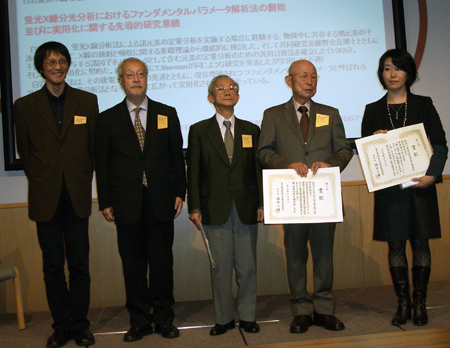Dr. G. J. Havrilla (Los Alamos National Lab.,
November 2009 Archives
For many years, substantial effort has been devoted to developing a good mirror for preparing a small X-ray beam. Professor K. Yamauchi (
Dr. I. Han (Ağrı İbrahim
Foamlike, cellular structures of the monolayer of organic capped nanoparticles can sometimes be observed on liquid surfaces. Professor M. K. Sanyal (Saha Institute of Nuclear Physics,
Nanometer scale dipole moments in the polarization clusters in BaTiO3 are believed to be thermally excited and thermally relaxed within a picosecond time scale. However, so far, there have been no reports on the direct observation of the dynamics of these dipole moments in such a very short time scale. The limitation here is mainly due to the low spatial coherence of the X-ray beam, in particular when synchrotron radiation is used as a light source. Professor K. Namikawa (Tokyo Gakugei Univ,
So far, X-ray microscopy with many types of lens has achieved great success in the observation of biological cells. In order to extend the limits of spatial resolution and efficiency, X-ray diffraction microscopy (also called coherent X-ray diffraction imaging), which uses coherent X-rays and some image reconstruction algorithms instead of an optical lens system, is now considered as a promising procedure to see whole cells at once and pick out much smaller features, down to around 10 nm or even less. A research group led by Professor C. Jacobsen (
Professors T. Narayanan (ESRF, Grenoble, France), M. Giglio (XFEL, Hamburg, Germany) and their collaborators have recently published an interesting paper on a novel method to map the two-dimensional transverse coherence of an X-ray beam. The technique uses the dynamical near-field speckles formed by scattering from colloidal particles, which are executing Brownian motions. It is possible to measure the change of the interference fringes, and consequently the fluctuation of speckles. It was found that the coherence properties of synchrotron radiation from an undulator source are obtained with high accuracy. For more information, see the paper, "Probing the transverse coherence of an undulator X-ray beam using Brownian particles", M. D. Alaimo et al., Phys. Rev. Lett., 103, 194805 (2009).
The recipient of the 4th Asada Award, which is presented in memory of the late Professor Ei-ichi Asada (1924-2005) to promising young scientists in X-ray analysis fields in Japan, is Dr. Akiko Hokura (Tokyo Denki Univ., "Study on accumulation of heavy metals in phytoremediation plant by synchrotron radiation micro XRF imaging and XAFS analysis"). From this year, the Discussion Group of X-ray Analysis, the Japan Society for Analytical Chemistry decided to establish the special award to recognize scientists who exhibit outstanding achievement and make a substantial contribution to the advancement of the X-ray analysis field. The recipient of the special award 2009 is Dr. Toshio Shiraiwa, who contributed greatly in the early days of X-ray absorption spectroscopy by means of his short-range order theory ("The theory of the fine structure of the X-ray absorption spectrum", J. Phys. Soc. Jpn. 13, 847 (1958)) and also provided the basis of the fundamental parameter method in X-ray fluorescence by Fujino-Shiraiwa's formula ("Theoretical calculation of fluorescent X-ray intensities in fluorescent X-ray spectrochemical analysis", Jpn. J. Appl. Phys. 5, 886 (1966)) The ceremony was held during the 45th Annual Conference on X-Ray Chemical Analysis, Japan, at Osaka City University, Osaka.

From right to left: A. Hokura, T. Shiraiwa, S. Ikeda, H. Wakita and H. Hayashi.
The discovery of X-rays was named the most important modern scientific achievement in a poll conducted for the Science Museum London, beating the Apollo spacecraft and DNA. Nearly 50,000 members of the public voted in the museum or online. The emblem of the





